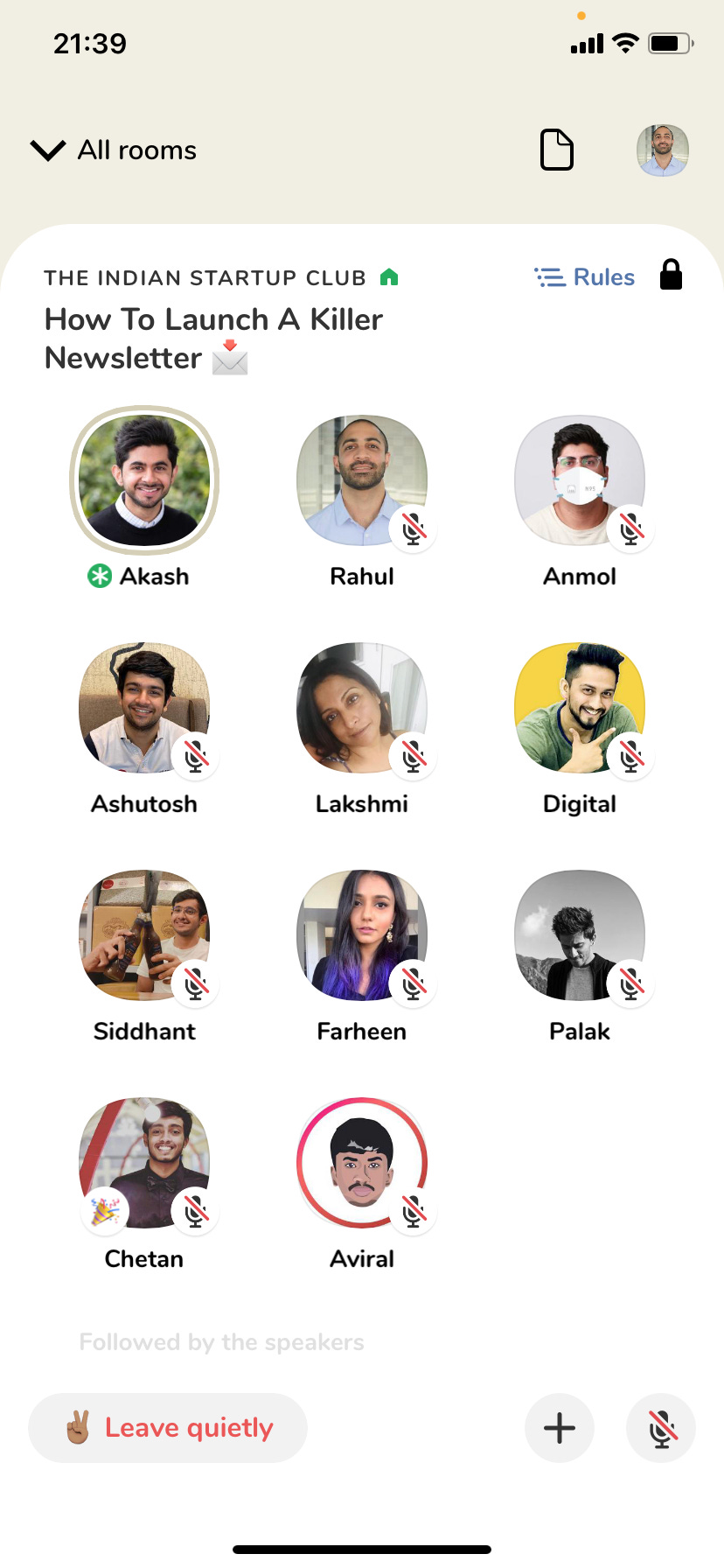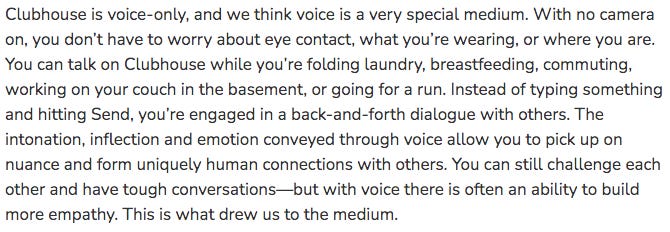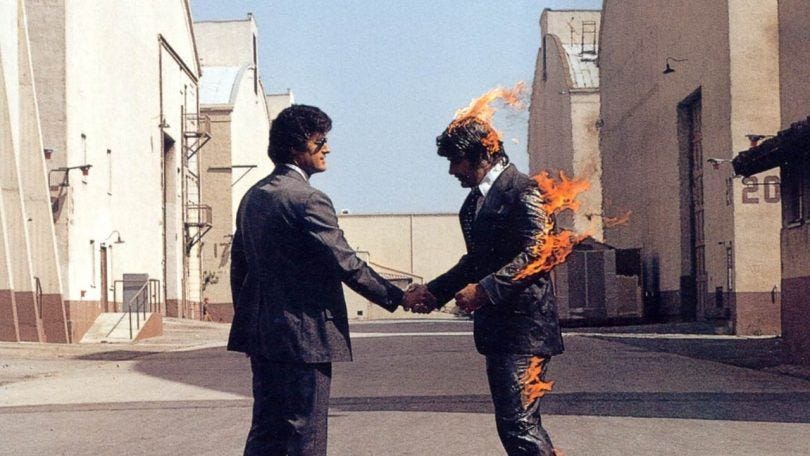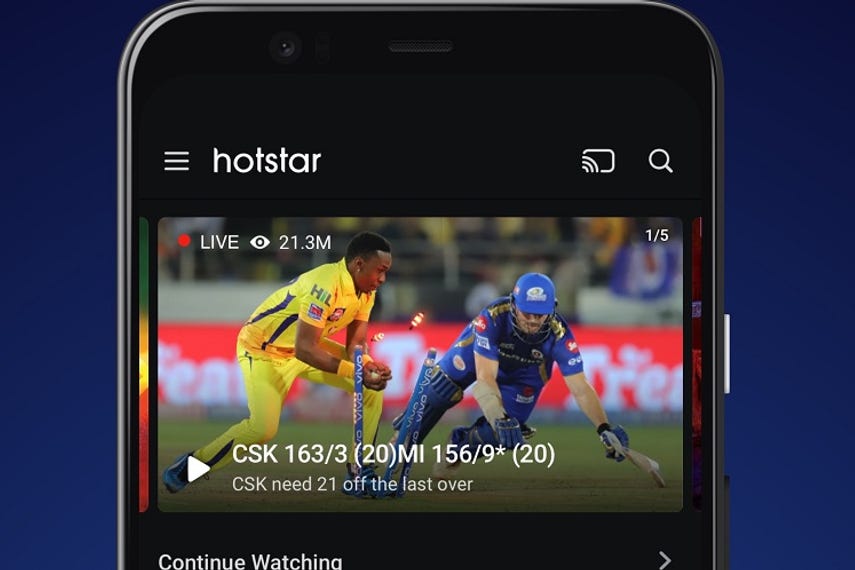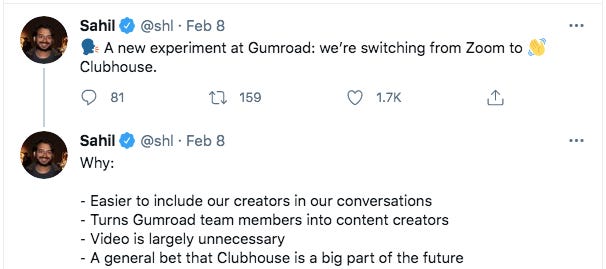Clubhouse Killed The Webinar Star
What the future holds for the next big Next Big social frontier
The 29th of December was a big day for me. No, it’s not the date I got married, had a kid or started a new company. Nor is it the day I scribbled down early drafts of my New Years resolution, or buried the ghosts of 2020.
Far more significantly, it’s the day I finally admitted defeat in a multi-year resistance and upgraded to iOS 13.0 (from what feels like iOS B.C.) primarily so I could see what the fuss was about Clubhouse.
After a couple of months on the app, I can’t say for sure if I’m late to the party or right on time…but there’s definitely a party. And yeah, you kinda need an invite.
It doesn’t take long to *get* why Clubhouse is cool, and even less to jump ahead to all compelling ways it could wedge itself into people’s daily lives. I thought it would be fun to lay out some of those possibilities below.
But first…
What’s a Clubhouse?
For the uninitiated, Clubhouse is an audio-first social media app that lets users create chat rooms or ‘clubs’ to host free flowing live conversation. People can drop in and out of rooms as they wish. Users can raise their hands if they want to be invited ‘on stage’ to participate in the discussion. You’re free to lurk around and listen in or ‘leave quietly’ to explore what else is happening. People can build a following similar to how they would on Twitter or Instagram.
On first glance it feels as if you’ve teleported into a series of live podcasts. There are virtual roundtables as far as you can scroll featuring enthusiastic conversations on topics ranging from ‘fintech in Nigeria’ to ‘Jordan vs LeBron’ to ‘mental health advice for influencers’ to ‘best ways to get rid of grass stains’ and literally anything else you can possibly imagine.
Clubhouse was launched in March 2020 by co-founders Paul Davidson and Rohan Seth, both of whom had spent the past decade tinkering with ideas for the next big social platform. True to its moniker, Clubhouse played the ‘exclusivity’ card perfectly by restricting the app to invite-only access and catering just to iOS users (though an Android app is finally on the way).
It didn’t take long for business to pick up. Clubhouse quickly became the premier watering hole for the wildlife of Silicon Valley, aided along the way by a $12 million Series A round from Andreessen Horowitz in May last year. For most of 2020, the app played host to countless spontaneous discussions between VCs, founders, tech operators and enthusiasts, all ruminating on the latest ripples in the techno-zeitgeist.
Clubhouse began to really enter mainstream pop-tech consciousness only in the latter half of 2020 and early 2021. This was partly the natural result of its invite-based user acquisition strategy gathering momentum and shapeshifting into a critical mass.
But what made it so intriguing as a new social platform was the way in which new creators on Clubhouse were unearthing the full potential of the medium.
In the past couple of months, Clubhouse has played host to:
a live rendition of the Lion King musical complete with a 40-member cast, live instrumentation, a choir and a series of flashing scenes courtesy of a clever use of the performers’ profile icons
a debate between the Mayors of Miami, San Francisco and Austin to discuss the recent exodus of tech professionals from Silicon Valley and ensuing implications of this talent redistribution for their respective cities
an off-the-cuff interview with Elon Musk on the (now) weekly Clubhouse room called ‘The Good Times Show’ which featured a spontaneous appearance from Robinhood CEO Vlad Tenev to discuss the recent controversy around the suspended trading of Gamestop stock
a media scrum with the founder and CEO of Bumble, Whitney Wolfe Herd, talking about her company’s historic IPO, while in a concurrent room thousands of people tuned in to ‘shoot your shot: nyu girls roasting tech guys’ which is exactly what it sounds like
That’s not to say that Clubhouse has only been good for the odd viral moment. On any given day on the app, you will find people organising discussions on current events, book clubs, company townhalls, virtual dinner parties, informal ‘water cooler’ sessions as a break from work, weekly round-up shows on different sectors, fireside chats with founders, politicians and celebrities - if there’s something worth discussing, there’s probably a room for it on Clubhouse.
With each passing week, as the population of users on the app expands to include a more diverse set of participants (outside of the tech/tech-adjacent community), we’re starting to see (in real time) what happens when creativity and technology collide at full speed.
I’ve spent enough time on the app to be convinced that Clubhouse is set to become a permanent fixture in our media landscape. And apparently, so has Andreessen Horowitz, who led a reported $100 million Series B round in Clubhouse in January 2021 that valued the company at around $1 billion. This might appear lofty for a young enterprise that was still only hovering at around 2 million weekly active users in January this year. But that valuation is going to appear quaint once Clubhouse attains true ubiquity, and the second order effects of the medium are fully unleashed.
We’ve officially entered the audio-first era of social media. And if you think Clubhouse is just a flash in the pan, you just haven’t been listening closely.
Welcome to Wireless
“It's not true I had nothing on, I had the radio on” - Marilyn Monroe
Clubhouse is the first real success story of the Airpod era. When Apple launched its range of wireless ‘earbuds’ in late 2016, they were met with much heckling from the peanut gallery for their elimination of the time-hallowed headphone jack in newer versions of the iphone. The mainstream narrative suggested that people would rather cling to their old phones than be coerced into buying an additional hardware accessory. But like most tech trends over the last three decades, Apple proved they were ahead of the curve, and the rest of the consumer tech industry dutifully followed suit with their own wireless iterations.

The ubiquity of ‘always-on’ wireless headphones has expanded the surface area of the attention economy. Amidst an all-out war for eyeballs, the incumbent generation of social media heavyweights have left a gaping void in the defence of their Death Stars.
The founders of Clubhouse alluded to this in a blog post from last year, writing:
It is worth pointing out that Clubhouse isn’t the first iteration of an audio-based social app. Hell, it isn’t even the first audio app from the same founders. Before they launched Clubhouse, Paul and Rohan were building a product called Talkshow which aimed to make it easy for people to record and livestream impromptu podcasts with their friends. The idea was to enable users to start spontaneous conversations with their connections that could be instantly ‘hosted’ and recorded as a podcast. The loose collection of ingredients that made up the initial Talkshow proposition were eventually fully baked into the finished product we now refer to as Clubhouse.
While Paul and Rohan iterated their way to product-market fit, a fresh batch of social startups have also sniffed out the opportunity that lies between our ears.
In her newsletter ‘In Bed With Social’, Marie Dolle helpfully arranges the players in this bubbly social-audio game into four teams, categorising these upstarts as:
- audio extensions to existing social apps
- vertically focused voice chat apps typical found in the world of e-sports
- products that help you connect with your existing social network
- audio applications centred around ‘social discovery’ (i.e. where Clubhouse fits in)
And this is without accounting for audio-adjacent apps like Zoom and Houseparty that are video-first by design, but respectively enjoyed their moments in the limelight last year as the world shut shop and moved online.
Even going further back to the early days of the web, ‘talk-radio’ was one of the killer apps that highlighted the potential of audio-focused media on the internet. Long before the Joe Rogans and Call Her Daddys of the world built their empires, Carl Malamud was the first person to experiment with an internet-based radio show in 1993, where he conducted weekly interviews with scientists and ‘computer experts’.
However, if you were trying to find the products and applications with the most direct lineage to Clubhouse, then audiobooks and podcasts represent the most accurate incarnations of Clubhouse ancestors. The former is set to become a $13.45 billion industry by 2027, propelled by the promotional muscle of industry giants like Audible, Amazon and Google. The latter is now a bonafide mainstream media vertical, set to grow at a compounded annual growth rate of 27.5% for the next half decade. Podcasting has drawn significant attention and investment from both incumbent tech heavyweights (Spotify, Apple) as well as a feisty set of smaller players (Luminary, Stitcher, Overcast, and others). With companies now offering tools to easily create, edit and distribute podcasts, and advertisers looking for newer ways to reach consumers, the podcasting revolution has spawned a new class of celebrities and internet-native media brands, and consequently sparked a mad scramble for the rights to purchase exclusive intellectual property.
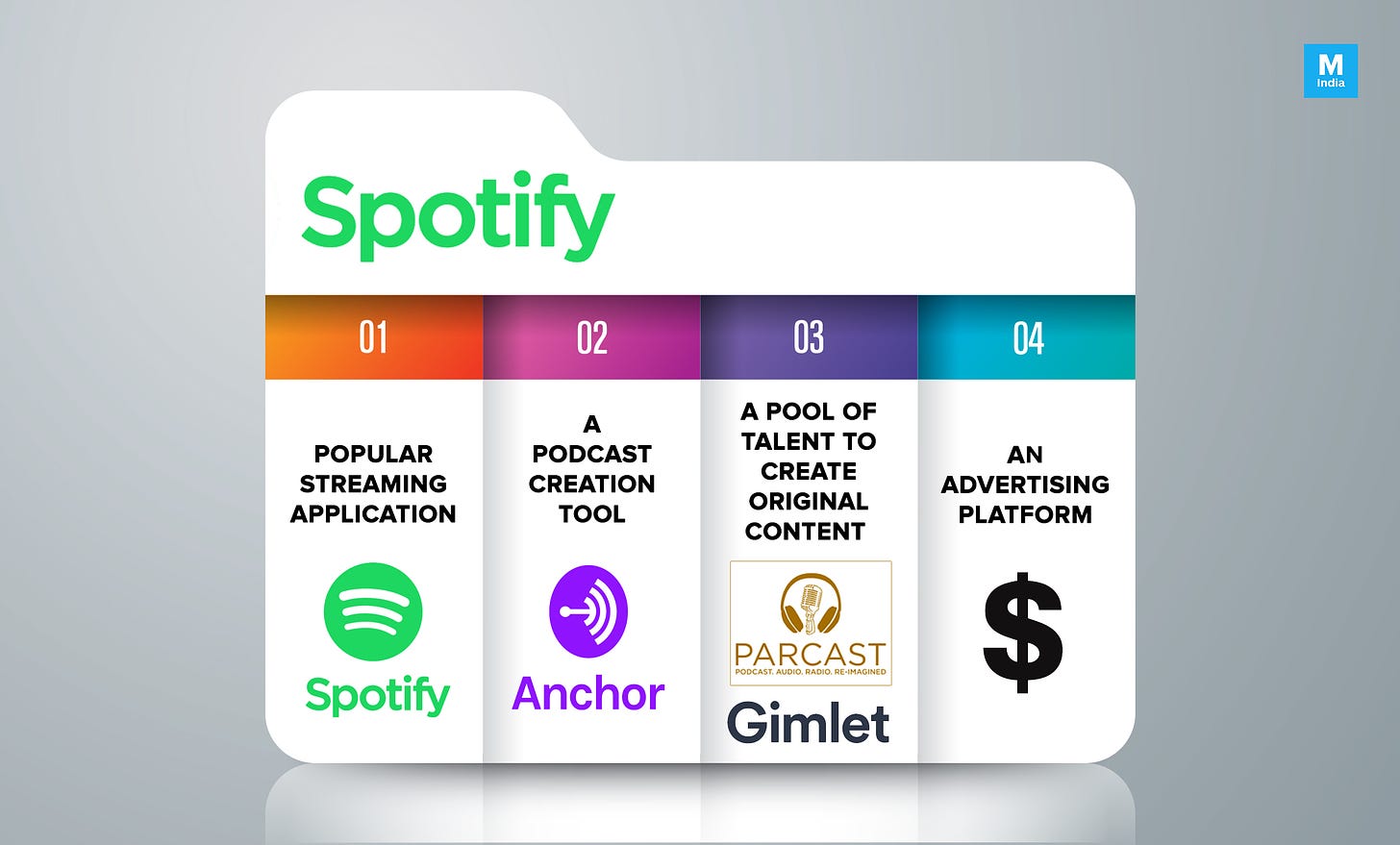
What makes the growth of podcasts and audiobooks most relevant to the Clubhouse story is that both forms of media have helped people get used to the idea of hosting a voice inside their head that isn’t their own.
When you add all of these new flavours of audio-based content to the unprecedented success of wireless headphones and other voice-enabled smart devices, you create the perfect storm for the arrival of a new social media juggernaut.
But what makes Clubhouse different?
If LinkedIn is like exchanging business cards with fellow professionals at a business conference, and Twitter is like hanging out with the same folks at a karaoke bar afterwards, the initial Clubhouse experience feels like something in between. Its like a conversation around the watercooler at the office, but sometimes that watercooler is filled with beer. And sometimes the office is your local cafe, or a concert, or a gameshow, or the zoo.
Clubhouse has managed to stir together all the essential ingredients that make up a sticky social media platform. Opening the app is like parachuting into serendipity. You never know what conversations you might wander into or better yet, who you might bump into. By allowing you to follow people you don’t know, there’s always a chance you could stumble upon topics and people you weren’t aware of before. The format allows you to learn from and engage with interesting people in real time, aided by the nuance that makes audio a richer form of content than text. Alternatively you might realise that the people who come across as witty or sagely on Twitter aren’t able to replicate that magic in an impromptu setting, meaning that we’re likely to see the emergence of a new cast of micro-celebrities suited to extemporaneous public speaking (and whatever fresh hell that brings).
To be sure, Clubhouse isn’t shying away from this. Getting comfortable with the gory imperfections of a real conversation between real people is a hallmark of the Clubhouse experience. A feature, not a bug. Its why the app requires you to tie your identity to a cell phone number, which helps to avoid the trouble caused by anonymous trolls (an issue that still plagues platforms like Twitter to this day).
However your actual profile on the app is sparse. There’s no room for a carefully manicured image library. There’s no place to pin your best tweets. You don’t even have a timeline of favourite articles and links to lean on. The only cards in your deck are a display picture and a brief bio. This is a subtle way of demonstrating that to build a following on Clubhouse, you need to make an effort to be part of the conversation i.e. you have to be seen and heard on Clubhouse.
Unless you already have a significant public following that’ll tag along wherever you go, there is no other proof of work for you to display than the actual time you spend interacting with others in Clubhouse rooms. In a sense this means that the ‘content’ you contribute to Clubhouse is ephemeral, making it a closer cousin of Snapchat, than it is of Twitter, Facebook or Instagram.
The other implication of putting ‘real people’ front and centre of the app is that Clubhouse is marking itself out as a bastion of the emerging creator economy. Over the past 12-18 months Silicon Valley has shown much love to the tools and platforms that enable people to turn their passions and unique skills into sustainable careers. From influencers on Instagram to streamers on Twitch to writers on Substack, the media landscape of the digital age features the usurping of legacy institutions by individual creators. Armed with the software to scale and monetise their interests, we are seeing the reinvention of media by amateurs whose efforts to inform and entertain are being supercharged by the Internet.
Legacy brands and companies managed to find a home in traditional social media platforms like Facebook, Twitter or Instagram because they could hide behind a logo and profile to appear personable and human-like. But on Clubhouse (at least for now) there’s no plans to allow corporations to create branded profiles. Even if organisations can be represented by their executives or employees, ultimately the success of these efforts will come down to the ability of a speaker to be engaging in a live audio setting.
Creators are the lifeblood of social media platforms. And contrary to the majority of social media platforms where the most prolific content creators are often unable to capture the value they generate, Clubhouse is making sure to recognise the importance of creators right from the jump. Over the next few months the company plans to launch the first tests “to allow creators to get paid directly—through features like tipping, tickets or subscriptions”. They also plan to use part of the new funding round to roll out a “Creator Grant Program” to support emerging creators on the app. Don’t be surprised to see a new wave of mainstream celebrities (gameshow hosts, newscasters, singers, comedians etc) beginning their professional journeys as entertainers on Clubhouse.
The above image is a screenshot from the Final match of the 2019 Indian Premier League, where at one point 18.6 million people tuned in at the same time on OTT streaming platform Hotstar, breaking the global record of concurrent users for any kind of live streaming event.
Why is that relevant to this piece? Because the single greatest weapon in the Clubhouse arsenal is that conversations take place live and in real time. There’s no recordings (officially), no do-overs, no post-game highlights and no replacements. The speakers, topics and interactions within a particular room blend together to create a unique user experience, and as a consequence - a unique piece of content. What this effectively means is that the content you find on Clubhouse is content that you can’t get anywhere else.
There’s a reason why legacy TV networks (and newer social media platforms) shell out boatloads of money to secure the broadcasting rights to live events every year. Its because in a world of instant access to entertainment, the surest way to consistently draw attention to your product is to offer an experience that retains its maximum potency only on immediate consumption. The appeal of live events is a function of two powerful human desires - the reward of being able to boast that ‘you were there’, and the ‘fear of missing out’ on something special. Today you can find the same podcast recordings on Spotify, Apple, Youtube and countless other platforms courtesy the magic of RSS feeds. You can spend hours scrolling through the profiles of interesting people on Twitter or Instagram, accessing all the cool things they’ve posted or said over the years. You can always catch up on TV shows or movies you’ve missed on Netflix, Disney+ and other streaming services. But if you miss that spontaneous pop cultural moment happening ‘right now’ on Clubhouse, chances are you won’t catch it again.
That’s why I think the novelty of Clubhouse won’t be short lived. There’s something special about sharing an experience with other people in real time. It’s what makes ‘big’ events like the World Cup Final or the season finale of Game of Thrones feel larger than life. The memes and gifs, the debates and debriefs - they’re often more fun than the events themselves. Its that cherished sense of ‘monoculture’ that has increasingly become a casualty in a world of instant gratification and on-demand media. Everyone has their own perfectly curated, perfectly unique diet of recreation and entertainment that fits around our individual schedules. And here comes a social media platform thats betting on us abandoning our habits to show up at the same place at the same time regardless of what else we have going on.
We’re now living in a time where even face to face conversation has become infinitely more complicated than it was a year ago. It isn’t surprising to me that Clubhouse has taken off. Timing is everything. When the bars, offices, cafes, gyms and restaurants around the world closed their doors in March 2020, people needed a new place to hang out. And Clubhouse opened for business.
Do the numbers add up?
Here’s where things get interesting. As impressive as Clubhouse’s anointment as the new ‘it girl’ of consumer tech has been, there’s still the question of a $1 billion valuation to justify so early on in its journey. With user numbers hovering in the 10 million range in late February and still no sign of an Android app, there’s still a long way to go. The metamorphosis from upstart to unicorn has been quick. But it becomes apparent from the way people are using the app, that Clubhouse could be set to rudely crash the parties of several different industries.
Assuming it achieves a reasonable level of ubiquity, I can see Clubhouse staking a claim to disrupt major verticals like:
the $5.32 billion global teleconferencing industry (if people start to realise that organising and hosting catch-ups on Clubhouse is easier than using any other video or audio conferencing tool). This is similar to how Slack managed to assert its dominance as a serious enterprise communications tool despite resembling a whimsical consumer chat application. Clubhouse could become the default medium for earnings calls, customer polls, press junkets, townhalls and interviews.
the $400 billion market for virtual events i.e. Clubhouse’s home turf. The pandemic (and the ensuing global lockdown) has been the biggest tailwind for startups offering digital interfaces as a replacement for our day-to-day activities. Companies like Bevy, Run The World, Airmeet, Hopin, Touchcast, Hubilo, Banzai and others have collectively raised more than $640 million in the last 12 months on the back of their promise to provide a sanctuary for people to connect online (both personally and professionally). Because it spans horizontally across industries and use cases depending on the needs of its users, Clubhouse could become the first port of entry for people that want to replicate their face-to-face interactions in the virtual world.
the booming market for celebrity shout-outs, thats helped industry pioneer Cameo arrive at the cusp of a $1 billion valuation on the back of a stellar 2020 where their customers spent over $100 million on shout-outs from public figures. Aside from video, Clubhouse can do everything Cameo can do (i.e. provide an interface for people to personally connect with public figures). One of the coolest parts of Clubhouse in its (still) early days is the potential to bump into ‘celebrities’ from the world of business, politics and entertainment and basically just have a chat. It wouldn’t be hard to double down on this, letting users pay to be in the same room with their idols at a certain time and for a certain duration. This opens up Clubhouse to becoming a forum for things like Shark Tank-style pitch rooms, live DJ sessions, expert masterclasses, job interviews and virtual dinner parties.
the $165 billion mobile gaming market. Remember HQ Trivia, the viral mobile trivia game that took over the world in 2018? It was a clever gimmick. They convinced millions of users to tune in live (twice a day) to participate in a short quiz. Users stood a chance to win real money if they answered all 12 questions correctly. Although the app eventually flamed out last year, HQ Trivia widened the imagination of users and game designers when it came to building the next viral mobile sensation. ‘Live’ moments and multiplayer social experiences are the future of mobile gaming. Clubhouse has the first part down. People are already organising rooms around activities like quizzes and karaoke. What if Clubhouse let its users share a piece of media (memes, gifs, tweets etc) within a room as a supporting prompt to the conversation? How long would it take to build the first viral pictionary game on Clubhouse? Could Clubhouse become a platform for people to host live games with their friends?
the unchartered territory representing the market for audio-first digital communities i.e. Reddit-for-audio. Reddit itself has owned ‘the front page of the internet’ since its launch in 2005 and recently doubled its valuation to $6 billion after a new $250 million funding round in February 2021. Compared to other social media platforms, Reddit has made its name on the strength of its individual communities or ‘subreddits’. Regardless of who you are or what you’re looking for, chances are you’ll find your tribe somewhere in the vast archipelago of niche communities that make up the 18th most visited site on the Internet. Despite the growing popularity of apps like Slack, Discord and Telegram for hosting online communities, no one has really solved for this use case outside of a text-based format. Clubhouse is already playing host to rooms built around unique interests (book clubs, music genres, sports teams etc). When it comes to filling the ‘Reddit-for-audio’ gap, there’s really no other candidate staking their claim to the title quite like Clubhouse.

the aforementioned $1 billion podcasting industry. Clubhouse has several potential points of attack when it comes to podcasting. To be specific, I think it represents the first real threat to Spotify’s throne. The latter is starting to see its multimillion dollar bet on podcasting finally pay off. Spotify has been able to ascend to the top of the podcasting heap on the back of its investments in podcast infrastructure (Anchor, Gimlet), original and exclusive content (The Joe Rogan Experience, The Michelle Obama Podcast, The Ringer Podcast Network), and an integrated music+podcast app experience (unlike Apple). The strategic shift to podcasting was a clever attempt to ‘own’ the audio market, plugging a hole in its initial music-only streaming service. However Clubhouse has demonstrated that ‘social audio’ could be a third wave in the overall audio landscape. Things start to get weird if Clubhouse facilitates the recording of conversations from the app itself (which would be a risky move) or becomes the preferred solution for discovering good audio content. Like any good creator tool, Clubhouse has given users a quick and dirty way to start broadcasting audio to their fans/followers without needing to go through the production headache of creating and promoting a podcast. I’m sure Spotify and Apple will respond to the Clubhouse threat in their own way this year. And we’ll find out if this town is big enough for another audio giant.
I’m interested to see which major use cases Clubhouse eventually solves for, and which ones are discarded as gimmicks. Here’s the kicker though - the largest market that Clubhouse is gunning for is the 24 hours that make up your day. If Clubhouse forces itself into your daily distraction rotation i.e. if it becomes one of the apps that people flick open to get their dopamine fix, then that should give pause to the likes of Netflix, Youtube, Twitch, Spotify and every other platform that’s offering some form of on-demand entertainment. There’s a formidable new addition to the shark tank of the attention economy.
This hype train can move in so many different directions. Each new product feature shipped opens up a new use case to test out and a new potential market for Clubhouse to enter. Paid access to rooms, exclusive memberships to clubs, tipping and subscription services for creators, sponsored/branded rooms - all catering to a global audience. Aside from being a fun alternative to radio and podcasts, there’s real business value to be extracted here. For Clubhouse critics it might be difficult to see the whole picture only because it is still being drawn out.
The story of Silicon Valley investors passing on Uber in its early days has become the stuff of legend. Initially dismissed as a low-tech upgrade on black cab services for niche markets, Uber would prove its detractors wrong by transforming the entire face of global urban mobility. Despite being only a year old, Clubhouse has already attained unicorn status because it has a visible path to disrupting a number of different media forms. Once you see all the ways creators are moulding the medium to fit their purpose (for local news, speed dating, sports radio, guided meditation etc), suddenly the numbers and the narrative don’t seem like such an odd pairing. Clubhouse is on its way to becoming a fixture in the future of how we work and play.
Final thoughts
Clubhouse deserves credit for shortening the time it takes for a social platform to go from frivolous recreational outlet to materially important media channel. Maybe its because we’re hyper attuned to what’s new these days? Or maybe its because tech cycles are generally shortening? It might just be that we’ve all been indoors for a year and yearning for more social connection? Either way, when you compare Clubhouse’s journey with that of its most natural competitors, it is telling that Facebook, Twitter, Instagram and Snapchat all spent several years as (mostly) harmless toys before graduating into the commercial behemoths they are today. I suspect Clubhouse will have to eliminate the training wheels far sooner than that.
“If we don’t create the thing that kills Facebook, someone else will. 'Embracing change' isn’t enough. It has to be so hardwired into who we are that even talking about it seems redundant. The Internet is not a friendly place. Things that don’t stay relevant don’t even get the luxury of leaving ruins. They disappear.” - Facebook Employee Handbook
What’s new in consumer tech rarely stays new for long. Snapchat had to learn this the hard way when seemingly every other social platform shamelessly cooked up their own recipe for Snapchat’s eponymous Stories feature (with varying levels of success). More recently TikTok found its short video format being cloned by the likes of Instagram (Reels) and other imitators hoping to capture some of the viral success it enjoyed in the first half of 2020. Clubhouse is already seeing competition heat up courtesy of Twitter’s new ‘Spaces’ feature for live audio rooms. ‘Spaces’ may actually prove to be a legitimate threat given it can piggyback on Twitter’s existing user base and its availability to Android users. There’s actually precedent for this eventuality from a few years ago. In 2015 Twitter acquired an app called Periscope to aid their live-streaming efforts as a direct response to the explosive growth of Meerkat (a similarly buzzy app that captured the imagination of the public just like Clubhouse). Spoiler alert: things didn’t work out well for Meerkat, who couldn’t cope with the integrated experience that Periscope could offer via Twitter. Even just this past week, the CEOs of Facebook and Spotify, Mark Zuckerberg and Daniel Ek, revealed in a Clubhouse conversation that both companies were also working on their own interactive social audio efforts. My take: Clubhouse will fend off these challenges on the strength of their product and the promotional muscle of Andreesen Horowitz. Either way, audio-as-a-feature seems like an inevitability, which means that the Space Race is just getting started.
I’m also curious to see how Clubhouse responds to facing the full wrath of a mainstream media that has detected a new threat to their kingdom. Clubhouse presents journalists with a new puzzle to solve. How do you report on a noteworthy event that only exists for a brief moment in time unless you were actually there? Is it possible to keep tabs on all the conversations happening in all the rooms on Clubhouse? What if you miss something interesting? What if you misreport something contentious? How do you actually verify what actually happened? If people start hosting interviews, earning calls, and press junkets on Clubhouse, what will happen to traditional news media? If Clubhouse is where the ‘big’ conversations are taking place, does that mean journalists will need to readjust their focus to covering what happens on Clubhouse?
These are open questions based mostly on hypotheticals at the moment. But with each new addition to the decentralised media stack, the centuries-old foundations of legacy media houses start to resemble a shaky tower of Jenga bricks. To draw a parallel, Substack (another a16z portfolio company) has recently drawn the ire of the mainstream press because of its mission to help writers go independent. The exodus of popular journalists leaving their corporate employers to set up personal media brands on Substack has raised the alarm bells at institutional publications. If Clubhouse wants to have a seat at the big boy table they will have to go through their own trial of fire. We should expect to see a fair share of headlines this year focusing on all the scary things happening on Clubhouse. But to me, that’s probably a sign that they’re doing something big.

Lastly, the biggest unknown variable when it comes to predicting Clubhouse’s eventual place in popular tech culture is estimating the effect on user experience once Clubhouse attains true ubiquity. At last count, Facebook had 2.8 billion global monthly active users, TikTok had 1 billion, and Twitter and Snapchat have 330 million and 249 million users respectively. Clubhouse has managed to draw all this attention with a relatively tiny user base of ~10 million. At this number, being on Clubhouse still feels like a somewhat intimate experience. You see familiar faces at similar times through the day. The room sizes are still small enough to accommodate interaction between audience members and speakers. You can make genuine connections easily and it feels like you could still access anyone who spends a considerable time on the app.
But what happens when the Android app is released? Do the mechanics of Clubhouse change at 100 million users? How do you moderate a room with 100k attendees? How do you assess whether someone in the audience is attending a session to contribute to the debate in a meaningful way or just to troll the speakers? How do you maintain the quality of rooms when there’s a sudden influx of users (both good and bad)? Will it require a delicately balanced algorithmic feed? People might lose interest in the app if they can’t find something that immediately catches their interest. It wouldn’t take long for Clubhouse fatigue to set in if users have to sample several different rooms to find something worth their time.

I’m bullish on Clubhouse figuring all this stuff out. I do, however, think the app will look a lot different with 100 million users than it does at 10 million. Clubhouse will have to find the sweet spot between being an open forum for recreational conversation, and a valuable tool providing the infrastructure for audio-based media. Maintaining the quality of conversations and participants is also a good problem to solve. But that’s where a bit of ingenuity around subscriptions and paid access will come into play, not to mention some natural milestones on the product roadmap (moderator tools, social scoring etc).
I don’t think this genie goes back in the bottle. With each new piece of software that replicates more of our physical lives online, we get closer to becoming full fledged co-inhabitants of the ‘real’ and virtual worlds. We now have the conversational layer of the Metaverse in place, and Clubhouse will have plenty to say as this new era of immersive consumer technology gathers steam in the coming years.
It took me a month to write this thing. If you made it all the way here and enjoyed reading this piece, why not take a couple of seconds to help spread the word?
Or if you want to yell at me for wasting your time, you can find me on Twitter at @RahulSanghi1, or on Clubhouse every Thursday at 7:00 pm where I co-host the weekly India Fintech Huddle.






